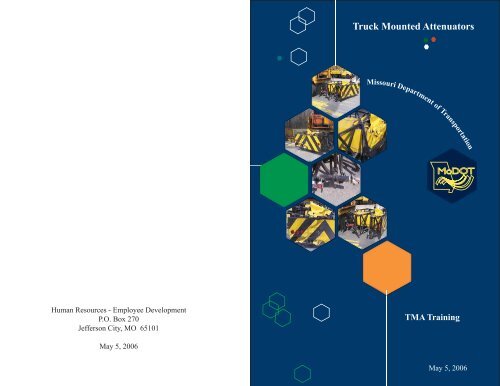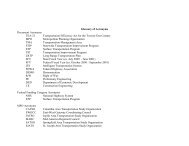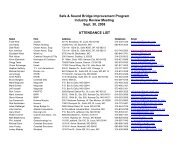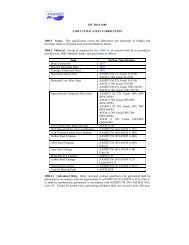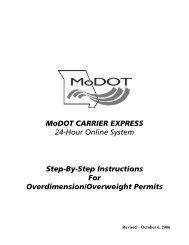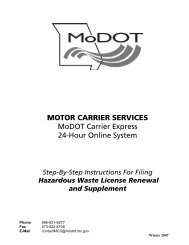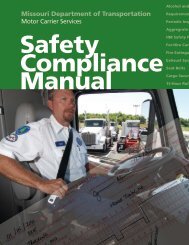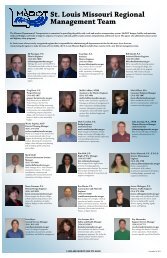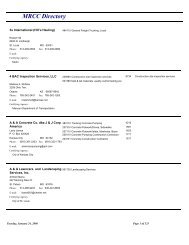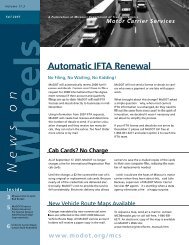truck-mounted attenuator (TMA) - Missouri Department of ...
truck-mounted attenuator (TMA) - Missouri Department of ...
truck-mounted attenuator (TMA) - Missouri Department of ...
You also want an ePaper? Increase the reach of your titles
YUMPU automatically turns print PDFs into web optimized ePapers that Google loves.
Truck Mounted Attenuators<br />
<strong>Missouri</strong> <strong>Department</strong> <strong>of</strong> Transportation<br />
Human Resources - Employee Development<br />
P.O. Box 270<br />
Jefferson City, MO 65101<br />
<strong>TMA</strong> Training<br />
May 5, 2006<br />
May 5, 2006
Employees Name: ___________________ Building: _________
Contents<br />
Introduction to Truck Mounted Attenuators<br />
(<strong>TMA</strong>’s) ...............................................................................................1<br />
The Need for Training .........................................................................1<br />
Training ...............................................................................................1<br />
Course Objectives ...............................................................................1<br />
Section I – Driver Characteristics .......................................................3<br />
Qualifications <strong>of</strong> a <strong>TMA</strong> Driver ........................................................3<br />
The Responsibility <strong>of</strong> a <strong>TMA</strong> Driver ................................................3<br />
Crashworthy Devices ........................................................................3<br />
Protective Vehicle and Roll-ahead Distance .....................................4<br />
Reaction Time ...................................................................................5<br />
Truck-Mounted Attenuators ..............................................................5<br />
Section II – Equipment/Safety Concerns ............................................7<br />
Seat belts ..........................................................................................7<br />
Storage <strong>of</strong> Equipment ......................................................................7<br />
Enter/Exiting Traffic with a <strong>TMA</strong> .....................................................8<br />
Aligning Wheels ..............................................................................10<br />
Checking Mirrors ............................................................................10<br />
Rotation <strong>of</strong> Drivers .........................................................................10<br />
Emergency Planning .......................................................................11<br />
If an Incident/Accident Occurs .......................................................11<br />
Removing a <strong>TMA</strong> from the Scene ..................................................12<br />
Returning to Work ...........................................................................12<br />
Section III – Operational Issues ........................................................14<br />
Storage <strong>of</strong> the <strong>TMA</strong> ........................................................................14<br />
Markings and Lighting ....................................................................14<br />
Flashing Arrow Panels ....................................................................15<br />
Section IV - Typical Scenarios ..........................................................18<br />
Lane closure on Multi-lane Highway .............................................19<br />
Mobile Operation on Divided or Multi-lane Highways ..................20<br />
Lane Closure <strong>of</strong> Interior Lane on Multi-lane Highway ..................21<br />
Shoulder Work on Divided Highways ............................................22<br />
Mobile Operation on Two-lane Highways ......................................23<br />
Lane Closure on Two-lane Highways Using Flaggers ....................24<br />
Horizontal and Vertical Curves with Geometric Obstructions .......25<br />
I
Introduction to Truck Mounted Attenuators<br />
(<strong>TMA</strong>’s)<br />
The Need for Training<br />
As the driver <strong>of</strong> a <strong>truck</strong>-<strong>mounted</strong> <strong>attenuator</strong> vehicle, your job is<br />
one <strong>of</strong> the most important on the crew. You are responsible for<br />
making sure that all other employees are adequately protected<br />
from errant vehicles in or around a work zone. It is the goal <strong>of</strong><br />
MoDOT to provide consistent use <strong>of</strong> <strong>TMA</strong>’s statewide.<br />
Truck-<strong>mounted</strong> <strong>attenuator</strong>s are designed to absorb the energy<br />
<strong>of</strong> an errant vehicle. Your job is to make sure that you are in<br />
the proper location, provide ample roll-ahead distance, and<br />
adequate warning to your co-workers and traveling public, when<br />
applicable.<br />
Training<br />
All employees that drive a <strong>truck</strong>-<strong>mounted</strong> <strong>attenuator</strong> (<strong>TMA</strong>) will<br />
be trained in the proper methods <strong>of</strong> installation, transporting,<br />
setup, operations, and preventative maintenance <strong>of</strong> the unit. To<br />
ensure that an employee understands his/her responsibility, every<br />
operator must successfully demonstrate the proper methods<br />
<strong>of</strong> attaching a <strong>TMA</strong> to a <strong>truck</strong> and perform operational and<br />
preventative checks and maintenance on the unit.<br />
Course Objectives<br />
After completing this training, you should be able to understand<br />
the following:<br />
Qualifications <strong>of</strong> the <strong>TMA</strong> driver<br />
Your responsibility as a <strong>TMA</strong>/crash <strong>truck</strong> driver<br />
The NCHRP test(s) and recognize the importance <strong>of</strong> them<br />
The roll <strong>of</strong> a protective vehicle and define its purpose<br />
The roll-ahead distance and when you should adjust those<br />
distances<br />
Notes:<br />
A protective vehicle shall be used while work is in progress. The<br />
protective vehicle shall be equipped with a <strong>TMA</strong> and flashing<br />
arrow panel and positioned at least 150 feet in the advance warning<br />
area <strong>of</strong> the workspace. The protective vehicle may be eliminated<br />
if the roadway is posted at 45 mph or below. The work vehicle is<br />
equipped with a flashing arrow panel and uses activated rotating<br />
lights and strobe lights.<br />
If the <strong>TMA</strong> is in a stationary operation, the wheels should be<br />
aligned with traffic and the <strong>truck</strong> should be in neutral with the<br />
parking brake set.<br />
In mobile operations, the <strong>TMA</strong> <strong>truck</strong> operator should be positioned<br />
at least 150 feet in the advance warning area <strong>of</strong> the workplace and<br />
observant to all surrounding conditions. The wheels should be<br />
aligned with the traffic.<br />
When working on hills, curves, or areas where sight distances<br />
may occur, the <strong>TMA</strong> operator should be far enough back to allow<br />
motorist to see that work is being performed and that they should<br />
proceed with caution. It is recommended that another protective<br />
vehicle be placed close to the work space to eliminate errant<br />
vehicles from re-entering the lane where work is taking place.<br />
Where bridges, overpasses, or the sight distance restrictions are<br />
presented, the protective vehicle or <strong>TMA</strong> should stay behind the<br />
obstacle until the work has progressed past the blind spot.<br />
An additional protective vehicle or <strong>TMA</strong> <strong>truck</strong> should be<br />
considered closer to the work space to keep errant vehicles from<br />
re-entering the work space.<br />
1 26
Horizontal and Vertical Curves with Geometric Obstructions<br />
Scenario 7<br />
MoDOT’s policy on equipment usage in the cab while the<br />
<strong>truck</strong> is in operations<br />
Installation, removal, and performance <strong>of</strong> preventative<br />
maintenance on a <strong>TMA</strong><br />
State the difference between stationary and mobile <strong>TMA</strong><br />
operations<br />
25 2
Section I – Driver Characteristics<br />
Qualifications <strong>of</strong> a <strong>TMA</strong> Driver<br />
1. Be trained in <strong>TMA</strong><br />
operations and procedures<br />
2. Be alert, aware, observant,<br />
and able to react to<br />
surrounding conditions<br />
3. Be familiar with daily tasks and be able to apply<br />
appropriate typical applications<br />
The Responsibility <strong>of</strong> a <strong>TMA</strong> Driver<br />
It is the responsibility <strong>of</strong> the driver to make sure crew members<br />
are protected from the traveling public. The driver needs to be<br />
alert, attentive, and observant to the surrounding conditions. The<br />
driver should be able to constantly check his/her mirrors and be<br />
able to communicate effectively with the crew members.<br />
Crashworthy Devices<br />
NCHRP stands for: National Cooperative Highway Research<br />
Project<br />
NCHRP has two different types <strong>of</strong> crashworthy <strong>TMA</strong> devices:<br />
1.) NCHRP 230 was first done on a small compact car at 45<br />
mph on lower volume routes.<br />
2.) In 1999, NCHRP 350 was developed to increase<br />
crashworthy devices for vehicles on routes that are<br />
designated for 62 mph or greater. This test was performed<br />
using a <strong>TMA</strong> and a 1/2-ton vehicle.<br />
MoDOT is actively working to have all new NCHRP 350 <strong>TMA</strong>s<br />
on high-volume routes prior to 2008. NCHRP 230 <strong>TMA</strong>s are<br />
still adequate and will continue to be used on lower volume and<br />
lower speed routes. They have been proven to be a great tool to<br />
help protect employees as well as the traveling public.<br />
Lane Closure on Two-lane Highways Using Flaggers<br />
100’<br />
(5 channelizers min.)<br />
Protective Vehicle<br />
Roll-Ahead Space<br />
100’<br />
(5 channelizers min.)<br />
The tests were performed in a straight-on-collision and an <strong>of</strong>fsetcollision<br />
3 24<br />
BE<br />
PREPARED<br />
TO STOP<br />
(Optional)<br />
ONE LANE<br />
ROAD<br />
AHEAD<br />
ROAD<br />
WORK<br />
AHEAD<br />
S<br />
S<br />
S<br />
S<br />
35’<br />
max.<br />
B<br />
B<br />
S<br />
S<br />
S<br />
S<br />
Scenario 6<br />
Highway<br />
Type<br />
Two-Lane<br />
Undivided<br />
Multi-lane<br />
Undivided<br />
Multi-lane<br />
Divided<br />
ONELANE<br />
ROAD<br />
AHEAD<br />
ROAD<br />
WORK<br />
AHEAD<br />
L<br />
BE<br />
PREPARED<br />
TOSTOP<br />
Operation Location and Duration<br />
In Lane<br />
On Shoulders<br />
Mobile Stationary<br />
and Ramps<br />
and at<br />
Intersections<br />
Recommended Recommended Recommended<br />
Required Recommended Recommended<br />
Required Required Recommended<br />
(Optional)<br />
Note:<br />
A protective vehicle shall be<br />
used while work is in progress.<br />
The protective vehicle shall<br />
be equipped with a <strong>TMA</strong><br />
and flashing arrow panel and<br />
positioned at least 150 feet in<br />
the advance warning area <strong>of</strong><br />
the workspace. The protective<br />
vehicle may be eliminated if the<br />
roadway is posted at 45 mph<br />
or below. The work vehicle<br />
is equipped with a flashing<br />
arrow panel and uses activated<br />
rotating lights and strobe lights.<br />
If the <strong>TMA</strong> is in a stationary<br />
operation, the wheels should<br />
be aligned with traffic and the<br />
<strong>truck</strong> should be in neutral with<br />
the parking brake set.<br />
In mobile operations, the<br />
<strong>TMA</strong> <strong>truck</strong> operator should be<br />
positioned at least 150 feet in<br />
the advance warning area <strong>of</strong><br />
the workplace and observant to<br />
all surrounding conditions. The<br />
wheels should be aligned with<br />
the traffic.
Mobile Operation on Two-lane Highways<br />
Protective Vehicle<br />
Roll-ahead Space<br />
Scenario 5<br />
Highway<br />
Type<br />
Two-Lane<br />
Undivided<br />
Multi-lane<br />
Undivided<br />
Multi-lane<br />
Divided<br />
Operation Location and Duration<br />
In Lane<br />
On Shoulders<br />
Mobile Stationary<br />
and Ramps<br />
and at<br />
Intersections<br />
Recommended Recommended Recommended<br />
Required Recommended Recommended<br />
Required Required Recommended<br />
Note:<br />
A protective vehicle shall be used<br />
while work is in progress. The<br />
protective vehicle should be<br />
equipped with a <strong>TMA</strong> and flashing<br />
arrow panel and positioned at least<br />
150 feet in the advance warning area<br />
<strong>of</strong> the workspace. The protective<br />
vehicle may be eliminated if the<br />
roadway is posted at 45 mph or<br />
below. The work vehicle is equipped<br />
with a flashing arrow panel and uses<br />
activated rotating lights and strobe<br />
lights.<br />
If the <strong>TMA</strong> is in a stationary<br />
operation, the wheels should be<br />
aligned with traffic and the <strong>truck</strong><br />
should be in neutral with the parking<br />
brake set.<br />
In mobile operations, the <strong>TMA</strong> <strong>truck</strong><br />
operator should be positioned at least<br />
150 feet in the advance warning area<br />
<strong>of</strong> the workplace and observant to all<br />
surrounding conditions. The wheels<br />
should be aligned with the traffic.<br />
<br />
<br />
<br />
<br />
<br />
<br />
<br />
Important Note - NCHRP 350 crash tests were conducted on<br />
a 3/4 standard cab pickup. Vehicles larger than a standard cab<br />
pickup such as large SUVs, freight <strong>truck</strong>s, or semi’s weight<br />
more and require a greater stopping distance. <strong>TMA</strong> drivers<br />
should consider greater roll-ahead distance if conditions warrant.<br />
Protective Vehicle and Roll-ahead Distance<br />
A protective vehicle is defined as a vehicle used to protect workers<br />
or work equipment from errant vehicles.<br />
Protective vehicles are used to safeguard the work space from<br />
errant vehicles. In some operations, these devices also serve<br />
as platforms for signs and other devices used to warn traffic <strong>of</strong><br />
upcoming conditions or inform them <strong>of</strong> needed actions. For increased<br />
motorist, driver, and worker safety, the protective vehicle<br />
may be equipped with a <strong>truck</strong>-<strong>mounted</strong> <strong>attenuator</strong> as noted in the<br />
following section.<br />
Protective vehicles should provide sufficient warning to<br />
approaching traffic and maximum<br />
protection to workers and equipment.<br />
This implies the protective vehicle be<br />
positioned so that it is clearly visible<br />
to approaching traffic, minimizes<br />
any vehicular encroachment into the<br />
area between the protective vehicle<br />
and the work space, and maintains a<br />
recommended minimum <strong>of</strong> 150-foot<br />
clear roll ahead distance between the<br />
vehicle and the work space.<br />
23 4
The wheels <strong>of</strong> the protective vehicle should be aligned with<br />
traffic at all times. In addition, the emergency brake shall be set<br />
and the transmission put into neutral in stationary operations.<br />
Reaction Time<br />
While you are operating a <strong>TMA</strong> <strong>truck</strong>, your job is to protect<br />
the crew and yourself. If you notice an errant vehicle coming<br />
towards your <strong>TMA</strong> <strong>truck</strong>, you should try to alert the crew and<br />
proceed forward to lessen the impact.<br />
Note: If you do drive forward to lessen the impact, you should<br />
be observant <strong>of</strong> all crew workers and try to maintain at least<br />
150 roll-ahead distance. In instance where you do not have the<br />
recommended 150 roll-ahead distance, DO NOT roll forward to<br />
lessen the impact.<br />
Truck-Mounted Attenuators<br />
Truck <strong>mounted</strong> <strong>attenuator</strong>s are energy absorbing devices attached<br />
to the rear <strong>of</strong> <strong>truck</strong>s used as protective vehicles. These devices<br />
are designed to protect the motorist and protect the vehicle’s<br />
driver upon impact.<br />
In general, the guidelines for the use <strong>of</strong> these devices are shown<br />
in the following table:<br />
Highway<br />
Type<br />
Two-Lane<br />
Undivided<br />
Multi-lane<br />
Undivided<br />
Multi-lane<br />
Divided<br />
Mobile<br />
Operation Location and Duration<br />
In Lane<br />
Stationary<br />
On Shoulders<br />
and Ramps<br />
and at<br />
Intersections<br />
Recommended Recommended Recommended<br />
Required Recommended Recommended<br />
Required Required Recommended<br />
Shoulder Work on Divided Highways<br />
Protective Vehicle<br />
Roll-ahead Space<br />
Scenario 4<br />
Highway<br />
Type<br />
Two-Lane<br />
Undivided<br />
Multi-lane<br />
Undivided<br />
Multi-lane<br />
Divided<br />
Operation Location and Duration<br />
In Lane<br />
On Shoulders<br />
Mobile Stationary<br />
and Ramps<br />
and at<br />
Intersections<br />
Recommended Recommended Recommended<br />
Required Recommended Recommended<br />
Required Required Recommended<br />
Note:<br />
A protective vehicle shall be used<br />
while work is in progress. The<br />
protective vehicle should be<br />
equipped with a <strong>TMA</strong> and flashing<br />
arrow panel and positioned at least<br />
150 feet in the advance warning area<br />
<strong>of</strong> the workspace. The protective<br />
vehicle may be eliminated if the<br />
roadway is posted at 45 mph or<br />
below. The work vehicle is equipped<br />
with a flashing arrow panel and uses<br />
activated rotating lights and strobe<br />
lights.<br />
If the <strong>TMA</strong> is in a stationary<br />
operation, the wheels should be<br />
aligned with traffic and the <strong>truck</strong><br />
should be in neutral with the parking<br />
brake set.<br />
In mobile operations, the <strong>TMA</strong> <strong>truck</strong><br />
operator should be positioned at<br />
least 150 feet in the advance warning<br />
area <strong>of</strong> the workplace and observant<br />
to all surrounding conditions. The<br />
wheels should be aligned with the<br />
traffic.<br />
5 22
Lane Closure <strong>of</strong> Interior Lane on Multi-lane Highway<br />
Scenario 3<br />
Highway<br />
Type<br />
Two-Lane<br />
Undivided<br />
Multi-lane<br />
Undivided<br />
Multi-lane<br />
Divided<br />
Note:<br />
Operation Location and Duration<br />
In Lane<br />
On Shoulders<br />
Mobile Stationary<br />
and Ramps<br />
and at<br />
Intersections<br />
Recommended Recommended Recommended<br />
Required Recommended Recommended<br />
Required Required Recommended<br />
A protective vehicle shall be used while work is in<br />
progress. The protective vehicle shall be equipped<br />
with a <strong>TMA</strong> and flashing arrow panel and<br />
positioned at least 150 feet in the advance warning<br />
area <strong>of</strong> the workspace. The protective vehicle may<br />
be eliminated if the roadway is posted at 45 mph<br />
or below. The work vehicle is equipped with a<br />
flashing arrow panel and uses activated rotating<br />
lights and strobe lights.<br />
If the <strong>TMA</strong> is in a stationary operation, the wheels<br />
should be aligned with traffic and the <strong>truck</strong> should<br />
be in neutral with the parking brake set.<br />
In mobile operations, the <strong>TMA</strong> <strong>truck</strong> operator<br />
should be positioned at least 150 feet in the<br />
advance warning area <strong>of</strong> the workplace and<br />
observant to all surrounding conditions. The<br />
wheels should be aligned with the traffic.<br />
Section 1 - Review Questions<br />
1. The qualifications <strong>of</strong> a <strong>TMA</strong> driver are:<br />
a. Average intelligence, over 18 years <strong>of</strong> age, responsible<br />
b. Have a CDL, on probation, and over 18 years <strong>of</strong> age<br />
c. Be trained in <strong>TMA</strong> operations and procedures, alert,<br />
aware, and observant <strong>of</strong> the surrounding conditions.<br />
Be familiar <strong>of</strong> daily tasks and be able to apply typical<br />
applications<br />
d. Be seat belted in, familiar with the <strong>truck</strong>, and sleeping at<br />
the wheel<br />
2. All <strong>TMA</strong>’s should:<br />
a. Meet the National Cooperative Highway Research<br />
Project (230 or 350) standards for Truck <strong>mounted</strong><br />
<strong>attenuator</strong>s<br />
b. Be able to be safely <strong>mounted</strong> to the rear <strong>of</strong> a dump <strong>truck</strong><br />
c. Be able to withstand a side impact collision.<br />
3. The recommended minimum roll ahead distance <strong>of</strong> a<br />
protective vehicle is:<br />
a. 100 feet<br />
b. 150 feet<br />
c. 200 feet<br />
d. 250 feet<br />
When workers are setting channelizing devices, a<br />
<strong>TMA</strong> vehicle shall be used.<br />
Additional protective <strong>truck</strong>s or <strong>TMA</strong>’s should be<br />
used to assist in moving personnel and equipment<br />
into interior lanes.<br />
21 6
Section II – Equipment/Safety Concerns<br />
In most cases when a <strong>TMA</strong> is required, employees are exposed to<br />
high volume, higher speed routes. A <strong>TMA</strong> is designed to absorb<br />
the energy <strong>of</strong> an errant vehicle. A protective vehicle equipped<br />
with a <strong>TMA</strong> will increase your safety, protect your co-workers,<br />
as well as the traveling public.<br />
Seat belts<br />
Mobile Operation on Divided or Multi-lane Highways<br />
Scenario 2<br />
Operation Location and Duration Note:<br />
Highway<br />
Type<br />
Two-Lane<br />
Undivided<br />
Multi-lane<br />
Undivided<br />
Multi-lane<br />
Divided<br />
Mobile<br />
In Lane<br />
Stationary<br />
On Shoulders<br />
and Ramps<br />
and at<br />
Intersections<br />
Recommended Recommended Recommended<br />
Required Recommended Recommended<br />
Required Required Recommended<br />
A protective vehicle occupying any portion <strong>of</strong> a lane<br />
shall be equipped with a flashing arrow panel and<br />
a <strong>TMA</strong>.<br />
A protective vehicle on the shoulder shall be<br />
equipped with a flashing arrow panel. This<br />
protective vehicle should be equipped with a <strong>TMA</strong>.<br />
Seat belt usage is mandatory in a MoDOT owned or leased<br />
vehicles. It is extremely important that<br />
the driver <strong>of</strong> a <strong>TMA</strong> not only wears<br />
his/her seat belt, but also must have it<br />
adjusted properly.<br />
Properly adjusted seat belts may<br />
minimize or reduce injuries. A<br />
seat belt should be secured in the<br />
manufacturer’s locking device and<br />
should be snug across the chest.<br />
When a <strong>TMA</strong> <strong>truck</strong> has been involved in a crash, the operator<br />
should consult with the supervisor and/or the mechanic to see if<br />
there’s a need to replace the seat belts. A thorough inspection<br />
should be conducted by a mechanic or his/her designee to<br />
evaluate the integrity <strong>of</strong> the seat belt and the system associated<br />
with it.<br />
Storage <strong>of</strong> Equipment<br />
A clean <strong>truck</strong> is vital to the<br />
operator’s personal safety. The<br />
operator <strong>of</strong> the <strong>truck</strong> is responsible<br />
for making sure that the cab <strong>of</strong><br />
the <strong>truck</strong> is cleaned everyday.<br />
Removing all trash and debris and<br />
securing all loose items will help<br />
prevent injury to the operator in<br />
the case <strong>of</strong> a traffic crash.<br />
Protective Vehicle 1<br />
Protective Vehicle 2<br />
Protective Vehicle<br />
Roll-ahead Space<br />
7 20<br />
Lane<br />
Tape<br />
Length<br />
Where adequate shoulder width is not available,<br />
Protective Vehicle 2, equipped with a <strong>TMA</strong>, may<br />
drive partially or fully in the lane.<br />
Protective Vehicle 2 shall be equipped with an<br />
appropriate lane closure sign. A mounting height<br />
<strong>of</strong> 48 in. from the bottom <strong>of</strong> the sign to the road<br />
surface is recommended.<br />
Protective Vehicle 1 should be positioned at least<br />
150 ft. in advance <strong>of</strong> the work vehicle. This spacing<br />
may be minimized to deter traffic from driving in<br />
between the vehicles.<br />
A third protective vehicle (not shown) may be<br />
used with Protective Vehicle 1 in the closed lane,<br />
Protective Vehicle 2 straddling the edge line, and<br />
Protective Vehicle 3 on the shoulder.<br />
For interior lane closure, Protective Vehicles 1 and<br />
2 shall travel in the same lane as the work vehicle.<br />
These vehicles shall be separated by at least 150<br />
ft. A double headed arrow shall be displayed on<br />
the flashing arrow panels. On high speed roadways,<br />
a third protective vehicle should drive the right<br />
shoulder. This vehicle shall be equipped with a<br />
flashing arrow panel and an appropriate advance<br />
lane closure sign and be positioned a distance <strong>of</strong><br />
T2 from Protective Vehicle 2. The caution mode<br />
shall be displayed on the flashing arrow panel. A<br />
mounting height <strong>of</strong> 48 in. from the bottom <strong>of</strong> the<br />
sign to the road surface is recommended.<br />
For mobile operations on roadways posted at 45<br />
mph or below, the protective vehicles and <strong>TMA</strong>s are<br />
optional provided the work vehicle uses activated<br />
rotating lights or strobe lights.<br />
For mobile operations moving at a continuous<br />
speed within 15 mph <strong>of</strong> the posted speed and snow<br />
operations, the protective vehicles are optional<br />
provided the work vehicle uses activated rotating<br />
lights or strobe lights.
Lane closure on Multi-lane Highway<br />
Scenario 1<br />
Highway<br />
Type<br />
Two-Lane<br />
Undivided<br />
Multi-lane<br />
Undivided<br />
Multi-lane<br />
Divided<br />
Protective Vehicle<br />
Roll-ahead Space<br />
Note:<br />
Operation Location and Duration<br />
In Lane<br />
On Shoulders<br />
Mobile Stationary<br />
and Ramps<br />
and at<br />
Intersections<br />
Recommended Recommended Recommended<br />
Required Recommended Recommended<br />
Required Required Recommended<br />
A protective vehicle shall be used while work<br />
is in progress. The protective vehicle shall be<br />
equipped with a <strong>TMA</strong> and flashing arrow panel<br />
and positioned at least 150 feet in the advance<br />
warning area <strong>of</strong> the workspace. The protective<br />
vehicle may be eliminated if the roadway is<br />
posted at 45 mph or below. The work vehicle<br />
is equipped with a flashing arrow panel and<br />
uses activated rotating lights and strobe lights.<br />
If the <strong>TMA</strong> is in a stationary operation, the<br />
wheels should be aligned with traffic and the<br />
<strong>truck</strong> should be in neutral with the parking<br />
brake set.<br />
In mobile operations, the <strong>TMA</strong> <strong>truck</strong> operator<br />
should be positioned at least 150 feet in the<br />
advance warning area <strong>of</strong> the workplace and<br />
observant to all surrounding conditions. The<br />
wheels should be aligned with the traffic.<br />
Enter/Exiting Traffic with a <strong>TMA</strong><br />
When you have arrived at the job<br />
location, you may be required<br />
to switch lanes or move into the<br />
desired location.<br />
Always try to have the <strong>TMA</strong> in<br />
the lowered position while in the<br />
desired lane, but you may have to<br />
have the <strong>TMA</strong> in the up position<br />
until you reach the desired location, then lower the <strong>TMA</strong>.<br />
19 8<br />
Important Note: You may be required to store your lunch or<br />
other personal items in the cab <strong>of</strong> the <strong>truck</strong>. Make sure items are<br />
secured inside the cab and not placed on the dashboard, where<br />
they can become a projectile.<br />
When entering a lane <strong>of</strong> traffic, the operator should reach the<br />
traveling speed and then get into the desired lane <strong>of</strong> traffic. Once<br />
they’ve reach the desired lane, they should begin to reduce their<br />
speed until they reach operational speed or come to a complete<br />
stop. For operations where they must come to a complete stop,<br />
the operator should be aware <strong>of</strong> all motorists behind them, in<br />
front <strong>of</strong> them, and those trying to switch lanes.<br />
It may also be required for the <strong>TMA</strong> <strong>truck</strong> to get into a desired<br />
location and then allow work vehicles, slow moving vehicles, or<br />
other work equipment to enter the desired lane in front <strong>of</strong> them.<br />
This will allow traffic to slow down behind the <strong>TMA</strong> in order for<br />
the work vehicle to get to the desired location safely.<br />
Make sure no person or objects are directly behind you while<br />
you are lowering the <strong>TMA</strong>. The <strong>TMA</strong> should be visible in the<br />
mirrors when it is fully in the down position.<br />
When exiting, check your mirrors to see if any traffic is<br />
approaching from behind. When it is safe, begin driving forward<br />
while raising the <strong>TMA</strong>. Do not switch lanes until you know the<br />
<strong>TMA</strong> is in the full upright position.
Diagram 1<br />
Section IV - Typical Scenarios<br />
When entering a multi-lane highway during high traffic situations,<br />
it might be necessary to have a <strong>TMA</strong> <strong>truck</strong> positioned so<br />
that work vehicles can move in front <strong>of</strong> the <strong>TMA</strong> <strong>truck</strong>.<br />
Diagram 2<br />
The <strong>TMA</strong> <strong>truck</strong> should be the first vehicle to get to the desired<br />
lane and then allow all other work vehicles to enter the desired<br />
lane in front <strong>of</strong> the rear <strong>TMA</strong>.<br />
9 18
Section III – Review Questions<br />
1. Who should inspect chains and/or nylon straps prior to each<br />
use:<br />
a. Driver<br />
b. Supervisor<br />
c. Maintenance Supervisor<br />
d. Qualified person<br />
2. When an arrow board is used it should be:<br />
a. Sighted and aligned with approaching traffic<br />
b. Turned <strong>of</strong>f or covered<br />
c. Dimmed during daytime operations<br />
Aligning Wheels<br />
The wheels <strong>of</strong> the <strong>TMA</strong> should be aligned so they are parallel<br />
with traffic at all times. The emergency brake shall be set and<br />
the transmission put into neutral during stationary operations.<br />
Having the wheels parallel with traffic, allows the protective<br />
vehicle to roll-ahead with traffic. Provide adequate roll-ahead<br />
space <strong>of</strong> approximately 150 feet depending on hills, curves, or<br />
other sight distance items that might be present.<br />
Checking Mirrors<br />
Mirrors are vital to the safe and successful<br />
operation <strong>of</strong> a commercial vehicle since they<br />
allow the driver to see behind the vehicle.<br />
Auxiliary or convex mirrors give a larger field<br />
<strong>of</strong> view; however, they may distort the driver’s<br />
perspective by making objects appear smaller<br />
and farther away than they actually are.<br />
Important Note: As a <strong>TMA</strong> driver, you should be aware <strong>of</strong> the<br />
activity going on in front <strong>of</strong> you, to the sides <strong>of</strong> you, and behind<br />
you. Continuously checking the mirrors will ensure your safety<br />
as well as the safety <strong>of</strong> your crew members, and the traveling<br />
public.<br />
Rotation <strong>of</strong> Drivers<br />
When practical, drivers should be rotated throughout the day.<br />
Inattention, mental fatigue, and daydreaming may occur when a<br />
driver is in the <strong>TMA</strong> for long periods <strong>of</strong> time.<br />
Supervisors need to be aware <strong>of</strong> these variables and rotate<br />
drivers when feasible to eliminate some <strong>of</strong> the human factors.<br />
Having fresh, attentive employees in the <strong>TMA</strong> <strong>truck</strong> during<br />
moving operations will maximize the driver’s safety as well as<br />
the employees working in or around the <strong>TMA</strong> <strong>truck</strong>.<br />
17 10
Emergency Planning<br />
Having an emergency plan and an escape route should be a<br />
priority each time you start a new task or move to a new job<br />
location. Things that you should know:<br />
Who will you call if someone<br />
hits the <strong>TMA</strong> or <strong>truck</strong>?<br />
Who is responsible for all<br />
crew members?<br />
Is someone trained in First<br />
Aid/CPR?<br />
Is the scene safe or am I<br />
creating another hazard?<br />
Are incident/accident forms<br />
located within the <strong>TMA</strong><br />
<strong>truck</strong>?<br />
If an Incident/Accident Occurs<br />
Your first call should be to your District’s Customer Service<br />
Center, the second to your supervisor. Be sure to give the<br />
customer service representative:<br />
Your exact location<br />
o Use mile markers<br />
o Exit ramps/numbers<br />
o Direction you were<br />
traveling<br />
o County in which you are<br />
located in<br />
Description <strong>of</strong> incident or<br />
traffic crash<br />
Number <strong>of</strong> vehicles involved<br />
Type <strong>of</strong> emergency services needed (EMT, Paramedic, Fire<br />
<strong>Department</strong>, HazMat Crew, etc.)<br />
Complete all required Risk Management forms<br />
When closing multiple lanes, a separate unit shall be used to<br />
close each lane.<br />
Important Note – The flashing arrow panel should be in the<br />
caution mode until the <strong>TMA</strong> <strong>truck</strong> has reached its desired<br />
location or lane. Once the <strong>TMA</strong> <strong>truck</strong> has reached the desired<br />
lane, the directional arrow should be displayed.<br />
For moving lane closures on two-lane, undivided highways, the<br />
panel shall be deployed within the lane to be closed.<br />
For moving lane closures on multi-lane highways, one panel<br />
should be deployed on the shoulder and another shall be<br />
deployed within the lane to be closed. Where adequate space<br />
does not permit deployment <strong>of</strong> the unit on the shoulder, the unit<br />
may be positioned partially in the lane to be closed.<br />
When an interior lane is being closed by itself, two units shall be<br />
deployed within the lane to be closed. When closing multiple<br />
lanes, a separate unit shall be used to close each lane.<br />
Important Note: When deployed, the panel shall be sighted<br />
and aligned with approaching traffic to ensure visibility <strong>of</strong> the<br />
display.<br />
When roading a flashing arrow panel out to your work location,<br />
the unit should be in the down position, if unit can be lowered.<br />
11 16
Flashing Arrow Panels<br />
Removing a <strong>TMA</strong> from the Scene<br />
Flashing arrow panels are<br />
temporary traffic control devices<br />
that provide warning and<br />
directional information to assist<br />
drivers through or around a<br />
temporary traffic control zone.<br />
The overall dimensions <strong>of</strong> the<br />
panel arrow board are 60 inches<br />
wide by 30 inches high for <strong>truck</strong>-<strong>mounted</strong> units. Flashing arrow<br />
panels shall include 15 yellow elements.<br />
Flashing arrow panels may be operated in one <strong>of</strong> three operating<br />
modes:<br />
• Arrow<br />
<br />
• Double arrow<br />
• Caution<br />
The arrow mode is used when traffic has no choice but to go left<br />
or right.<br />
The double arrow mode is used when traffic has a choice to go<br />
right or left.<br />
The arrow and double arrow modes are used for stationary or<br />
moving lane closures on multi-lane highways.<br />
The caution mode is used for shoulder work, blocking the<br />
shoulder, work within a lane when the lane is not closed, and<br />
lane closures on two-lanes, undivided highways. When used<br />
during night operations, these displays shall be dimmed by 50<br />
percent, (if applicable).<br />
For stationary lane closures, the panel should be deployed on<br />
the shoulder or within an adjacent closed lane at the beginning<br />
<strong>of</strong> the lane or one-lane, using a two-way taper. Where adequate,<br />
space or the temporary traffic control plan does not permit this<br />
placement; the unit may be placed within the taper <strong>of</strong> the closed<br />
lane.<br />
When preparing to remove a damaged <strong>TMA</strong> from the scene,<br />
consider the following:<br />
Is additional equipment needed to cleanup the scene?<br />
Can the <strong>TMA</strong> cartridge be loaded onto a trailer or into the<br />
back <strong>of</strong> another <strong>truck</strong> bed?<br />
Strap the <strong>TMA</strong> together using MoDOT’s approved slings/<br />
straps to secure the load.<br />
Important Note: Drivers should use extreme caution when<br />
moving a wrecked <strong>TMA</strong> out <strong>of</strong> the lane <strong>of</strong> traffic. The unit may<br />
not be adequately attached at the anchor points and should be<br />
inspected prior to moving. Loose or broken parts should be<br />
secured before the <strong>TMA</strong> unit is moved.<br />
Returning to Work<br />
How an employee reacts to an incident depends on many life<br />
style characteristics. Our job is to ensure that every employee is<br />
given the chance to deal with situations effectively. MoDOT has<br />
options that supervisors and employees should consider:<br />
Supervisors and employees should just talk about the<br />
incident and debrief to see if anything could have been<br />
done differently.<br />
Employees can contact the Employee Assistance Program<br />
(EAP)<br />
Rotate drivers to keep employees out <strong>of</strong> the “hot-seat” for a<br />
long period <strong>of</strong> time.<br />
Supervisors are encouraged to talk with everyone involved to<br />
make improvements and learn from all discussions.<br />
15 12
Section II - Review Questions<br />
1. Lunch boxes, cell phones, and personal belongings are to<br />
be:<br />
a. Stored on the dash board <strong>of</strong> the <strong>truck</strong><br />
b. On the seat next to the driver<br />
c. Secured inside the <strong>truck</strong> or on the floor board <strong>of</strong> the<br />
<strong>truck</strong><br />
d. On the bed <strong>of</strong> the <strong>truck</strong><br />
2. The wheels <strong>of</strong> the <strong>TMA</strong> <strong>truck</strong> should be:<br />
a. Aligned with traffic<br />
b. Turned to the right<br />
c. Turned to the left<br />
3. The driver <strong>of</strong> the <strong>TMA</strong> <strong>truck</strong> should:<br />
a. Check his/her mirrors and be aware <strong>of</strong> activity going on<br />
around you<br />
b. Check his/her mirrors for vehicles speeding<br />
c. Check his/her mirrors for potholes<br />
d. Check his/her mirrors for the supervisor to show up on<br />
the job site<br />
4. Driver’s rotation should occur:<br />
a. When the driver falls asleep<br />
b. Every 15 minutes<br />
c. When practical, throughout the day<br />
d. After an incident<br />
Storage <strong>of</strong> the <strong>TMA</strong><br />
Section III – Operational Issues<br />
When the <strong>TMA</strong> is not en route to a<br />
location or is not in use, the safety<br />
chains or safety straps should<br />
be used to prevent the unit from<br />
accidental deployment.<br />
While the unit is in use, the chains<br />
or straps should be stowed away in<br />
the manufacturer’s approved location. This will prolong the life<br />
expectancy <strong>of</strong> the <strong>TMA</strong> and the cartridges.<br />
A qualified person should inspect the safety chains and/or nylon<br />
straps prior to each use.<br />
Markings and Lighting<br />
When a <strong>TMA</strong> is used during nighttime operations, the person<br />
assigned to be the Work Zone Supervisor shall ensure that<br />
all lighting has been dimmed according to the MUTCD<br />
Specifications for nighttime activities.<br />
The supervisor <strong>of</strong> the work zone should assign an individual to<br />
perform routine inspections <strong>of</strong> the work zone. This person is<br />
responsible for ensuring:<br />
Clear and simple messages are provided to the traveling<br />
public via message boards<br />
All signs are retr<strong>of</strong>lective and in operational condition<br />
A safe work environment is provided for employees<br />
Work crews do not blind motorists with area work lighting.<br />
(Lights from a pickup are not acceptable work lights.)<br />
Adequate roll-ahead distance is provided – at least 150 feet<br />
The traveling public is doing what we expect/intend for<br />
them to do (i.e., merge, move into/out <strong>of</strong> lanes, proceed<br />
with caution, etc.)<br />
13 14


